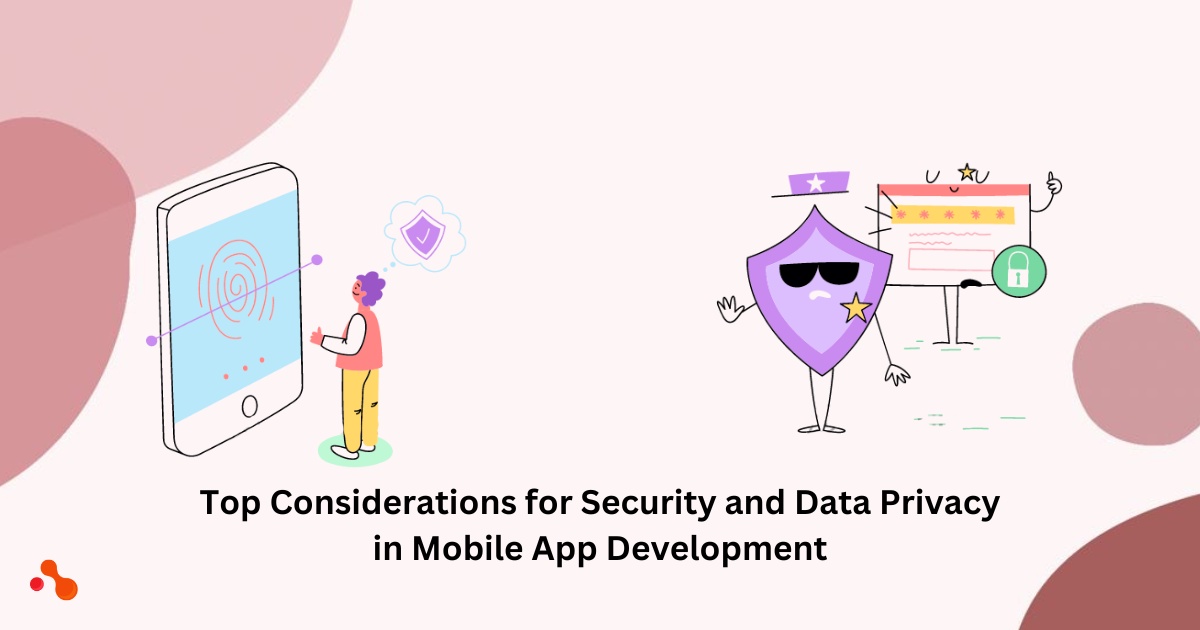Introduction
Mobile apps have become an integral part of our lives in today's digital age. Whether for social networking, shopping, or managing finances, mobile applications offer convenience at our fingertips. However, as the demand for mobile app development grows, so does the importance of ensuring security and data privacy. Mobile app development companies must prioritize these aspects to protect user information and maintain trust. This blog will explore the top security and data privacy considerations in mobile app development, highlighting critical factors for developers to remember.
Authentication and Authorization
Authentication and authorization play a crucial role in ensuring the security of mobile applications. This section will explore the importance of robust authentication mechanisms, the significance of two-factor authentication (2FA) and biometric authentication, secure authorization protocols, and best practices for secure authentication and authorization.
Importance of solid authentication mechanisms:
- Robust authentication mechanisms are essential to protect user data and prevent unauthorized access to mobile applications.
- They verify the identity of users before granting access to sensitive information, enhancing overall security.
- Robust authentication mechanisms minimize the risk of data breaches and identity theft.
Two-factor authentication (2FA) and biometric authentication:
- Two-factor authentication (2FA) adds an extra layer of security by requiring users to provide two forms of identification, such as a password and a unique code sent to their mobile device.
- Biometric authentication uses physical or behavioral traits, like fingerprints or facial recognition, to verify a user's identity, making it difficult for unauthorized individuals to gain access.
Secure authorization protocols:
- Secure authorization protocols ensure that only authorized individuals can access specific resources within a mobile application.
- These protocols use techniques like access control lists, role-based access control, or token-based authentication to grant appropriate access privileges.
- Properly implementing secure authorization protocols prevents unauthorized access to sensitive functionalities or data.
Best practices for secure authentication and authorization:
- Use complex and unique passwords for user accounts and enforce password policies, such as minimum length and character requirements.
- Regularly update and patch the authentication and authorization mechanisms to address potential vulnerabilities.
- Employ encryption techniques to protect sensitive user data during transmission and storage.
- Implement session management techniques to ensure that user sessions expire after a certain period of inactivity.
- Educate users about the importance of secure authentication practices, such as avoiding sharing passwords or using public Wi-Fi networks for sensitive transactions.
In conclusion, strong authentication and authorization mechanisms are vital for the security of mobile applications. By implementing two-factor authentication, biometric authentication, secure authorization protocols, and following best practices, mobile app development company can enhance the protection of user data and provide a secure user experience.
Secure Data Storage and Transmission
In the world of mobile app development, it is crucial to prioritize the security of user data. One of the critical aspects of ensuring data security is through secure data storage and transmission. Let's explore this topic further, using simple language and bullet points for easy understanding:
- Encrypting sensitive user data stored on the mobile device:
- Encryption is a technique that converts readable data into an unreadable format, known as ciphertext.
- Mobile app developers should implement robust encryption algorithms to protect sensitive user information stored on the device.
- For example, sensitive data like passwords, personal details, or financial information can be encrypted using algorithms like AES (Advanced Encryption Standard).
- SSL/TLS encryption for secure data transmission:
- SSL (Secure Sockets Layer) and its successor TLS (Transport Layer Security) are cryptographic protocols that ensure secure communication between a mobile app and a server.
- SSL/TLS encryption provides data privacy and integrity during transmission, preventing unauthorized access or tampering.
- For instance, when a user submits sensitive information through a mobile app, SSL/TLS encryption protects it from being intercepted by malicious attackers.
- Secure storage and transmission of authentication tokens and session data:
- Authentication tokens and session data are essential to secure user sessions within mobile applications.
- Mobile app developers should securely store and transmit these tokens and data to prevent unauthorized access.
- Using tokenization or one-time-use tokens adds more security to these processes.
- Best practices for secure data storage and transmission:
- Regularly update and patch the mobile app to fix security vulnerabilities.
- Implement strong access controls, such as user authentication and authorization mechanisms.
- Employ secure protocols and encryption standards throughout the app.
- Conduct security audits and penetration testing to identify and address potential weaknesses.
- Educate app users about data security practices, such as using strong passwords and avoiding public Wi-Fi networks.
By prioritizing secure data storage and transmission, mobile app development companies can instill trust in their users, safeguard sensitive information, and protect against potential data breaches.
App Permissions and User Consent
Regular Updates and Penetration Testing
Importance of Regular App Updates: • Regular updates are essential to patch security vulnerabilities and protect user data. • Vulnerabilities can be discovered in the operating system, third-party libraries, or the app itself, making updates crucial for fixing these issues. • Failure to update the app leaves it vulnerable to attacks and increases the risk of data breaches.
Conducting Penetration Testing: • Penetration testing is a proactive security measure where trained professionals simulate attacks on the app to identify security flaws. • It helps uncover vulnerabilities that might be missed during normal development and testing. • By identifying weaknesses, developers can address them before malicious actors exploit them.
Proactive Approach to Addressing Emerging Threats: • Mobile app development companies need to adopt a proactive approach to security by staying informed about emerging threats and trends. • Timely updates help address newly discovered vulnerabilities and protect the app from evolving attack methods. • Regularly monitoring security news and staying updated with industry best practices can significantly enhance app security.
Best Practices for Maintaining App Security: • Keep the app updated with the latest security patches and bug fixes provided by the operating system and third-party libraries. • Implement secure coding practices during app development to minimize the risk of introducing vulnerabilities. • Conduct regular penetration testing to identify and address security flaws. • Educate users about the importance of updating the app and enable automatic updates where possible. • Encourage users to provide feedback and report security concerns to improve the app's overall security posture.
Example: Let's say a mobile app development company releases an app for online shopping. Regular updates ensure that any security vulnerabilities discovered in the app or its dependencies are promptly patched. Without these updates, hackers could exploit the vulnerabilities, potentially compromising sensitive customer information like credit card details. Additionally, the company can hire ethical hackers to perform penetration testing on the app, which helps identify any weaknesses that could be exploited. By staying proactive and regularly updating the app, the company can ensure its customers' data remains secure and protected from emerging security threats.
In conclusion, regular updates and penetration testing are critical for maintaining the security of mobile applications. Following best practices and adopting a proactive approach to security helps mitigate risks, protect user data, and build trust among app users.
Conclusion
In conclusion, when it comes to mobile app development, ensuring security and data privacy should be a top priority for any mobile app development company. Developers can protect user data and maintain trust in their mobile applications by following best practices and considering key factors such as secure coding, data encryption, user authentication, and regular security audits. Remember, a reliable and trustworthy app development company will prioritize security and data privacy throughout development. Stay vigilant and prioritize security to safeguard user information.


No comments yet